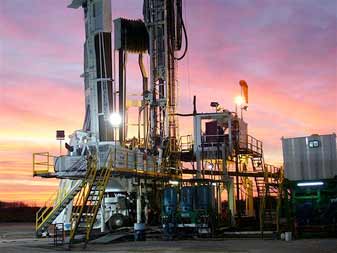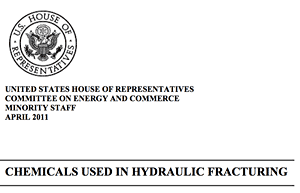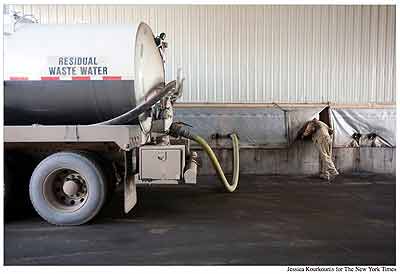Biblio
Special Community Forum:
Thursday, March 31, Friday, April 1, Saturday, April 2, 2011.
Cornell Law School | Free Admission
Natural gas drilling using hydraulic fracturing ("hydrofracking") may be poised to begin in Upstate New York.
...This heated issue is part of the larger state, national, and international energy picture. The conference will use natural gas drilling as a lens to explore energy policy, the global energy market, and the integral role the law can and must play in creating energy security and ensuring a sustainable future.
...The conference will explore, among other topics, the legal issues associated with natural gas drilling and energy policy, different scientific perspectives on how clean and sustainable natural gas is, alternative clean energy sources, and the potential risks and benefits of shale gas development in Upstate New York.
PLEASE NOTE: Seating is limited at most panels, and registration is first-come, first-served. Registrants not seated in the amphitheater where the panel is taking place will be seated in an adjacent amphitheater where the panel will be broadcast live via simulcast. Contact Ben Tettlebaum, bwt32@cornell.edu, with questions or concerns.
I attended the Energy Conference 3/31 - 4/2/2011.
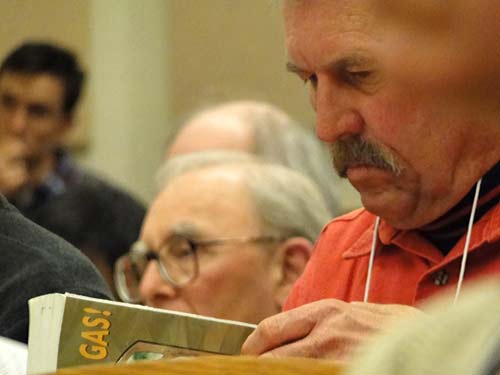
Getting serious about natural gas at the 2011 Cornell Energy Conference.
Photo by Neil Zusman.
See: Cornell University Law School - 2011 Energy Conference
First posted the photographs on 4/8 and liked how it played against Dylan and the Dead (1989) "All Along the Watchtower", but copyrights... I couldn't use Dylan and the Dead on YouTube- rock it Google.
But now I think the ballads about John Henry resonate for me - the classic man against machine tale, and I think that this conference was about that and more (mechanical, chemical). It needs a ballad. Sort of like the one about digging a tunnel for the railroad...but more about the one in progress, digging for the truth. The music is from the great Anthology of American Music. Vol. 2. (Neil Zusman, 2011-04-19).
“John Hardy” stands right next to “John Henry” as one of the most popular “figures” in the folk song tradition. (In the Anthology too, they are next to each other). In fact, many people combined the two songs and many scholars confused the two characters as Alan Lomax once said. Both were black railroad workers but their story is quite different.
The historical John Hardy killed a man during a crap game and was hanged for his crime. Before his execution he wanted to make peace with God so they sent a preacher and went to the river to baptise him. On the scaffold he claimed his repentance for his crime and probably sang some verses that would be included in the ballad that bore his name.
Harry Smith, ed. Anthology of American Music. Vol. 2. Smithsonian Folkways Recordings. 1997. "The Williamson Brothers & Curry: Gonna Die With My Hammer in My Hand".; "The Carter Family: John Hardy Was a Desperate Little Man."
Steel-drivin' men like John Henry used large hammers and stakes to pound holes into the rock, which were then filled with explosives that would blast a cavity deeper and deeper into the mountain. In the folk ballads, the central event took place under such conditions.
Eager to reduce costs and speed up progress, some tunnel engineers were using steam drills to power their way into the rock. According to some accounts, on hearing of the machine, John Henry challenged the steam drill to a contest. He won, but died of exhaustion, his life cut short by his own superhuman effort.
Carlene Hempel, Deb Procopio, Dan Shaver, Beth Novak. John Henry The Steel Driving Man. Electronic Resource. Accessed 2011-04-19.
Discover this great Anthology of American Folk Music by Harry Smith here and an even more amazing resource exploring it:
Gadaya. The Old Weird America. "Gonna Die with a Hammer in my Hand." Electronic Resource. Accessed 2011-04-19.
See: Congress Launches Investigation Into Gas Drilling Practices
Apr 16, 2011
Today Energy and Commerce Committee Ranking Member Henry A. Waxman, Natural Resources Committee Ranking Member Edward J. Markey, and Oversight and Investigations Subcommittee Ranking Member Diana DeGette released a new report that summarizes the types, volumes, and chemical contents of the hydraulic fracturing products used by the 14 leading oil and gas service companies.
The report contains the first comprehensive national inventory of chemicals used by hydraulic fracturing companies during the drilling process.
“Hydraulic fracturing has helped to expand natural gas production in the United States, but we must ensure that these new resources don’t come at the expense of public health,” said Rep. Waxman.
“This report shows that these companies are injecting millions of gallons of products that contain potentially hazardous chemicals, including known carcinogens. I urge EPA and DOE to make certain that we have strong protections in place to prevent these chemicals from entering drinking water supplies.”
See: U.S. Congress. Committee on Energy and Commerce. Minority Staff (Henry Waxman, Edward Markey, Diana DeGette). "Chemicals Used in Hydraulic Fracturing". Washington, D.C. April 2011. (PDF)
Universal Well Services, for example, told the Committee that it “obtains hydraulic fracturing products from third-party manufacturers, and to the extent not publicly disclosed, product composition is proprietary to the respective vendor and not to the Company.”31
Complete Production Services noted that the company always uses fluids from third-party suppliers who provide an MSDS for each product. Complete confirmed that it is “not aware of any circumstances in which the vendors who provided the products have disclosed this proprietary information” to the company, further noting that “such information is highly proprietary for these vendors, and would not generally be disclosed to service providers” like Complete.32
Key Energy Services similarly stated that it “generally does not have access to the trade secret information as a purchaser of the chemical(s).”33
Trican also told the Committee that it has limited knowledge of “off the shelf” products purchased from a chemical distributor or manufacturer, noting that “Trican does not have any information in its possession about the components of such products beyond what the distributor of each product provided Trican in the MSDS sheet.”34
In these cases, it appears that the companies are injecting fluids containing unknown chemicals about which they may have limited understanding of the potential risks posed to human health and the environment.
VI. CONCLUSION
Hydraulic fracturing has opened access to vast domestic reserves of natural gas that could provide an important stepping stone to a clean energy future. Yet questions about the safety of hydraulic fracturing persist, which are compounded by the secrecy surrounding the chemicals used in hydraulic fracturing fluids.
This analysis is the most comprehensive national assessment to date of the types and volumes of chemical used in the hydraulic fracturing process.
It shows that between 2005 and 2009, the 14 leading hydraulic fracturing companies in the United States used over 2,500 hydraulic fracturing products containing 750 compounds. More than 650 of these products contained chemicals that are known or possible human carcinogens, regulated under the Safe Drinking Water Act, or listed as hazardous air pollutants.
31. Letter from Reginald J. Brown to Henry A. Waxman, Chairman, Committee on Energy and Commerce, and Edward J. Markey, Chairman, Subcommittee on Energy and Environment (Apr. 16, 2010).
32. Letter from Philip Perry to Henry A. Waxman, Chairman, Committee Energy and Commerce, and Edward J. Markey, Chairman, Subcommittee on Energy and Environment (Aug. 6, 2010).
33. E-mail from Peter Spivack to Committee Staff (Aug. 5, 2010).
34. E-mail from Lee Blalack to Committee Staff (July 29, 2010).
by Ian Urbina:
Oil and gas companies injected hundreds of millions of gallons of hazardous or carcinogenic chemicals into wells in more than 13 states from 2005 to 2009, according to an investigation by Congressional Democrats.
...“Questions about the safety of hydraulic fracturing persist, which are compounded by the secrecy surrounding the chemicals used in hydraulic fracturing fluids,” said the report, which was written by Representatives Henry A. Waxman of California, Edward J. Markey of Massachusetts and Diana DeGette of Colorado.
...Some of the ingredients mixed into the hydraulic fracturing fluids were common and generally harmless, like salt and citric acid. Others were unexpected, like instant coffee and walnut hulls, the report said. Many of the ingredients were “extremely toxic,” including benzene, a known human carcinogen, and lead.
...Ms. Degette, and Representative Maurice D. Hinchey, Democrat of New York, recently reintroduced the FRAC Act, a bill that would require chemical disclosure from all drilling companies, including a provision that companies release proprietary information to health professionals if it is needed for treatment. The FRAC Act would also create an online registry of chemicals on a well-by-well basis, but it would require drillers to disclose what they plan to use before they fracture a well, as well as a post-fracturing report.
See: Urbina, Ian. “Millions of Gallons of Hazardous Chemicals Injected Into Wells, Report Says.” The New York Times 16 Apr. 2011. Web. 17 Apr. 2011.
See also: Texas Oil and Gas Acciountability Project. The Dark Side of the Boom: How Natural Gas Drilling in Texas Threatens Public Health and Safety: Sen. Lon Burnam Joins Calling for ‘Urgent’ Reforms
Thursday, April 14, 2011
Flowback: How the Texas Natural Gas Boom Affects Health and Safety
TEXAS OIL & GAS ACCOUNTABILITY PROJECT
FOR IMMEDIATE RELEASE: April 14, 2011
The Dark Side of the Boom: How Natural Gas Drilling in Texas Threatens Public Health and Safety: Sen. Lon Burnam Joins Calling for ‘Urgent’ Reforms
AUSTIN, TX, APRIL 14 – State, local and federal officials and regulatory agencies are failing to protect Texans from the health and safety risks of the natural gas boom, according to a report released today by the Texas Oil & Gas Accountability Project (OGAP).
Urgent Action on Water Withdrawal - see "Action" page
CPNY is a coalition of individuals and groups dedicated to halting the dangerous, destructive practice of high-volume hydrofracking for methane gas in our region.
This unconventional method of gas extraction is a huge and looming intrusion that signifies the industrialization of our area now rich in tourism, agriculture, recreational areas, wineries, and open spaces. We must defeat fracking to protect our families, the environment, our property values — indeed, our very way of life.
Our Vision: We say YES to that which promotes the health and vibrancy of our land, our resources, and ourselves. Our vision, like our work, is evolving.
Our Mission: Working together with other like-mined people and organizations, we aim to stop fracking before it gains a foothold in New York State. We inform, educate, and empower people to resist company directors, state and federal officials and all who frack our legislatures, and our public discourse.
We use the term “fracking” to mean all the processes involved in exploring, developing, extracting, disposing, storing, and distributing shale gas via high-volume, slick-water horizontal and vertical drilling, and secondarily but equally importantly to denote the “fracturing” of our health, environment, and communities.
We also do not use the term "natural" gas in regards to shale gas. The only natural state for gas trapped within shale rock deep in the ground underlying New York State is to remain where it is - serving as bedrock. The term "natural," like many other carefully chosen terms used by the extraction industry, is intended to give the false impression that shale gas is a benign and "clean, green" fuel, when in fact its extraction via this unconventional method, is as or more dirty than coal.
US coal mining companies have scored some points in their fight against the Environmental Protection Agency’s tough stance on mountaintop mining. A federal judge has ruled (PDF) in a preliminary decision that the EPA may have overstepped its legal authority by imposing strict new environmental standards on mining permits (via New York Times). The move comes just one day after the agency vetoed a permit for what would have been the country's largest mountaintop coal mine in Appalachia, West Virginia (see Nature’s blog here).
See: Ken Ward Jr. "Breaking news: EPA vetoes Spruce Mine permit." Coal Tattoo. Jan. 13, 2011.
The incoming Republican chairs of the House of Representatives plan to send the United States back to the Stone Age with respect to climate policy. All of them opposed the climate legislation supported by President Barack Obama, and now oppose limits on global warming pollution under the Clean Air Act. Several have accused climate scientists of doctoring data and suppressing dissent; the others merely claim climate policy is actually a conspiracy to destroy the American economy. Meet the climate zombies who will be in charge of developing all federal legislation for the next two years:
SENATE
HOUSE
See: Grist. Dec. 29, 2010. "Upton argues Obama plans to destroy America in the name of global warming."
Americans depend on clean and abundant water. However, over the past decade, interpretations of Supreme Court rulings removed some critical waters from Federal protection, and caused confusion about which waters and wetlands are protected under the Clean Water Act. As a result, important waters now lack clear protection under the law, and businesses and regulators face uncertainty and delay. The Obama Administration is committed to protecting waters on which the health of people, the economy and ecosystems depend.
U.S. EPA and the U.S. Army Corps of Engineers have developed draft guidance for determining whether a waterway, water body, or wetland is protected by the Clean Water Act. This guidance would replace previous guidance to reaffirm protection for critical waters. It also will provide clearer, more predictable guidelines for determining which water bodies are protected by the Clean Water Act. The draft guidance will be open for 60 days of public comment to allow all stakeholders to provide input and feedback before it is finalized.
The draft guidance will reaffirm protections for small streams that feed into larger streams, rivers, bays and coastal waters. It will also reaffirm protection for wetlands that filter pollution and help protect communities from flooding. Discharging pollution into protected waters (e.g., dumping sewage, contaminants, or industrial pollution) or filling protected waters and wetlands (e.g., building a housing development or a parking lot) require permits. This guidance will keep safe the streams and wetlands that affect the quality of the water used for drinking, swimming, fishing, farming, manufacturing, tourism and other activities essential to the American economy and quality of life. It also will provide regulatory clarity, predictability, consistency and transparency.
See: William Ringler sentenced to prison of Clean Water Act violation
See: Supreme Court Restricts Clean Water Act
Secretary of Energy Steven Chu has appointed a panel of seven scientific and environmental worthies to study the rapidly growing method of natural gas extraction known as hydraulic fracturing and to make recommendations about how it can be done more cleanly and more safely.
The group includes John Deutch, a former Central Intelligence Agency director; Kathleen McGinty, a former top White House environmental adviser; and Daniel Yergin, probably the best-known oil industry analyst in the country...
Broder's piece goes on to offer a smokescreen of protest by the right, but according to Dusty Horwitt of the Environmental Working Group, “An industry insider like John Deutch is completely unacceptable to lead this panel...It looks as if the Obama Administration has already reached the conclusion that fracking is safe.”
Dr. Chu announced his decision late Thursday. This being Washington, House Republicans immediately issued a press release denouncing the study as wasteful, duplicative and yet another example of regulatory red tape run amok.
On the other side of the Capitol, Senator Richard Burr, Republican of North Carolina, went them one better, introducing a bill to dismantle the Department of Energy and the Environmental Protection Agency...
The EWG press release presents a clearer picture of the Administration's positioning and refers to a study by Duke University researchers, that found high concentrations of methane in 68 wells near shale-gas drilling and hydrofracking sites in northeastern Pennsylvania and New York, confirming property owners’ suspicions that gas extraction was leaking methane into their drinking water.
The "Paper of Record" has just as much a right as any blogger to present the facts or distort them.
In, "E.P.A. Proposes New Emission Standards for Power Plants", I caught the editors of the Times editing out an account of how Ms. Jackson invited a group of second graders from a nearby elementary school to the announcement. Earlier today, Mar. 17, it was edited out. Was it Broder and Rudolf, or the Times? Are children not newsworthy?
"She invited a group of second graders from a nearby elementary school to attend the rule’s unveiling at her agency."
Why did the Times delete it? The article as it first appears will always be located here. (PDF). The Google cache will expire as soon as you read this. See for yourself, read between the lines.
(Neil Zusman, 2011-03-17).
See: Clifford Krauss: propagandist par excellence
See: E.P.A. Proposes New Emission Standards for Power Plants
See: Scientific Study Links Flammable Drinking Water to Fracking
See: U.S. Congress. Committee on Space, Science, and Technology. "Hearing Highlights Lack of Objectivity in Draft EPA Fracking Study--No Evidence of Drinking Water Contamination from Fracking, Witnesses Say". May 11, 2011
Excerpt of e-mail from Catskill Citizens for Safe Energy:
Anyone not living under a rock must be aware of the mountain of bad news that's recently come to light about fracking.
The New York Times recently ran an extensive three part series that detailed many of the dangers associated with fracking as well as the industry pressure that has forced state and federal agencies to turn a blind eye to practices known to put the public at risk.
Among the findings: Pennsylvania water treatment plants have been accepting radioactive drilling wastewater that is 2,000 times more polluted than permitted by federal drinking water standards. That means that one million gallons of wastewater would need to be diluted with 2 billion gallons of fresh water in order to meet minimal standards for human consumption.
Also last week: Arkansas ordered a temporary moratorium on new injection wells, which are suspected of causing 700 small earthquakes in the last six months alone.
Because about four million gallons of fracking fluid remains underground in each Marcellus well, every Marcellus well is an injection well. Even a single small earthquake could spell big trouble if it opens up fault lines and permits toxic fracking fluid to migrate into drinking water.
The EPA recently determined that methane leaks from natural gas operations are 9,000 times higher than previously suspected. Methane is a greenhouse gas twenty to thirty times more destructive than carbon dioxide.
See: ECONOMIC BENEFIT? REALLY?
As the horrific truth about the dangers of fracking continue to come to light, economist (and Catskill Citizens member!) Jannette Barth, Ph.D., continues to deconstruct the myth that drilling will be a boon to local communities and the state. Her latest report points out distortions and misstatements in the industry- funded studies that tout the economic benefits of fracking.
See: Janette Barth: Unanswered Questions About The Economic Impact of Gas Drilling In the Marcellus Shale: Don’t Jump to Conclusions.
See: Christopherson to study economic impact of gas drilling in Marcellus Shale.
Catskill Citizens for Safe Energy is a volunteer grassroots organization intended to give residents a voice in the emerging energy decisions in the Catskills.
Catskill Citizens for Safe Energy News Page.
See: Steve Coffman. (2009). The Safety of Fracturing Fluids – A Quantitative Assessment
According to the EPA's National Emission Inventory, Chevron was responsible for 4,030,422.95 pounds of green house gas emission pollution in Plaquemines Parish, Louisiana in 2002.
Chevron was the first international oil company to operate in Nigeria and has, for almost 40 years of operations there, practiced the wasteful process of burning off of gas associated with oil drilling.
This gas flaring has resulted in the flaring of billions of cubic feet of natural gas. These flares have and are wrecking havoc on the air and water quality in the Niger Delta. Communities living near the flares are suffering from a myriad of health issues and are more likely to get cancer and suffer from asthma as a result of breathing flare smoke. Many flares have been burning for over 20 years and in locations only a few hundred yards from the center of the nearest village.
According to the Canadian Public Health Association, gas flares contain as many as 250 toxins and their smoke emits particulate matter---including sulfur dioxide, nitrogen dioxides and carcinogenic substances as well as unburned fuel components, including benzene, toluene, xylene, and hydrogen sulfide. Exposure to benzene and its metabolites causes acute nonlymphocytic leukemia and a variety of other blood-related disorders in humans.
According to the US Environmental Protection Agency Flare smoke can cause aggravated asthma, increases in respiratory symptoms like coughing and difficult or painful breathing, chronic bronchitis, decreased lung function, and premature death.
Gas Flaring also causes acid rain, corroding roofs, acidifying lakes and streams and damaging vegetation. This acid rain, combined with frequent oil spills--totaling more than 10 Exxon Valdez spills--and dumping of toxic drilling waters into rivers has severely depleted fish stocks, which the people of the Delta rely on.
See: Chevron Human Energy Stories | Addressing Climate Change
See: Poison Fire
See: Rancho Los Malulos | A satirical view from the McGill Brothers Lease
See: Natural gas: the commodity world’s ugly duckling
See: Controversial gas 'fracking' extraction headed to Europe
See: As You Sow - Corporate Accountability, Shareholder Action, and ToxicsReduction
Covalent has been drilling near Cooperstown, NY. In 2008, it tried to purchase water from the Village of Cooperstown for their deep shale drilling. Jim Austin of The Cooperstown Crier (July 24, 2008) reports that the village board has voted not to move forward with the proposal, and Covalent plans to look to Cortland.
“Personally,” said Trustee Lynne Mebust, “I don’t see an upside for the village.” …
Prior to taking the vote, the board listened to comments from the public, which were largely against the sale of water.
Covalent Energy is a privately held exploration and development company focused on developing domestic and international unconventional energy resources.
If you are predisposed to distrust big business and the bureaucrats who regulate it, then “Gasland,” a soberly muckracking film about the health and environmental dangers of the current nationwide rush to drill for natural gas, will light a flame in you...
The accumulation of stories and sympathetic faces is persuasive; it’s buttressed by testimony from scientists like Theo Colborn and Al Armendariz, named regional director of the Environmental Protection Agency in Dallas since the film was completed. Most viewers who seek out “Gasland” are likely to share Mr. Fox’s outrage (which he expresses in melancholy tones) and to accept the picture, familiar and so often true, of heedless profiteering, co-opted and ineffective regulation, Orwellian spin control and innocent, ruined lives. Comparisons to the oil spill in the Gulf of Mexico will be unavoidable...
Mr. Fox shows a general preference for vivid images — bright red Halliburton trucks, beeping but unidentified scientific instruments — over the more mundane crossing the t’s and dotting the i’s of investigative journalism...
Mr. Fox closes with an ominous warning about the threat fracking poses to New York City’s watershed. New Yorkers who are frightened at the prospect will want to know that the state recently tightened regulations governing drilling in that area, at least temporarily.
Cornell University Cooperative Extension. Landowner Information. Links to Landowner Coalitions, Key Points for Property Owners, Gas Rights and Right-of-Way Leasing Considerations for Farms. Woodlands, and more.
See also: Cornell Cooperative Extension (CCE): Natural Gas Resource Center
Europe's dash for gas is leading Halliburton, Chevron and Exxon to consider bringing hydraulic fracturing across the Atlantic.
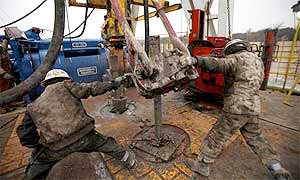
Workers at the Barnett Shale field of Fort Worth, Texas, where hydraulic fracturing technology is needed to release underground gas. Photograph: Robert Nickelsberg/Getty Images
Despite growing evidence from the US of a raft of negative environmental and social consequences of drilling for natural gas using the controversial hydraulic fracturing process, European energy companies are scrambling to secure licenses to roll out extraction projects this side of the Atlantic.
...Experts have increasingly expressed concern that the chemicals used in fracking may pose a threat underground or when waste fluids are transported or spilled.
...'Construction of pipelines could cause problems, but so could the construction of roads,' adds Kassenberg. 'If roads are built to transport water and gas then it will open up pristine countryside to mass tourism, and could bring an additional negative impact to the environment.'
See: France to Unlock Dirty Oil Under Paris With Texan Help
CNX Gas - (a CONSOL Energy subsidary), is the largest producer of natural gas in the Appalachian Basin.
A world record was set by CNX Gas for drilling the most cumulative feet with a single drill bit.
CONSOL Energy purchased the naming rights to the new arena for the Pittsburgh (Pa.) Penguins. CONSOL Energy Center is expected to open its doors in 2010.
On March 15, 2010, CONSOL announced the purchase of Dominion’s Exploration and Production business for $3.475 billion.
According to CONSOL, Dominion Exploration and Production is known as “one of the oldest and most active drillers in Pennsylvania and West Virginia”.
The transaction includes 1.46 million acres for oil and gas drilling with over 9,000 already-producing wells.
Sourcewatch notes that this transaction includes 491,000 acres of land in the Marcellus shale formation of Pennsylvania and West Virginia, and almost triples the amount of land rights CONSOL owns in the Marcellus area.
According to CONSOL’s press release, this purchase will make the company the largest producer of natural gas in the Appalachian basin and give CONSOL “a leading position” in the Marcellus area.
Note: The following articles are summaries only:
See: Consol To Pay $1.4M To End Coal Mining Pollution Suit
See: Va. Landowners Sue Consol Over Coalbed Methane










